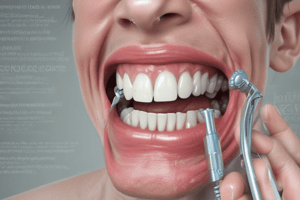Podcast
Questions and Answers
What is the key reason for achieving the correct diagnosis before treatment?
What is the key reason for achieving the correct diagnosis before treatment?
- To refer to a specialist
- To simplify the sequelae of pulpitis
- To avoid wrong treatment (correct)
- To handle uncertainties
What are the characteristics of normal periapical tissues?
What are the characteristics of normal periapical tissues?
- Chronic inflammatory cells
- No tenderness to palpation or percussion (correct)
- Presence of granuloma
- Tenderness to palpation or percussion
What distinguishes a periapical cyst from a granuloma?
What distinguishes a periapical cyst from a granuloma?
- Surrounded by collagenous fibers
- Presence of chronic inflammatory cells
- Attachment to the root surface (correct)
- Short course of severe symptoms
What does the term 'chronic' in relation to pulpitis mean?
What does the term 'chronic' in relation to pulpitis mean?
Which symptom is commonly associated with acute sinusitis?
Which symptom is commonly associated with acute sinusitis?
What can periradicular infection of premolar or molar teeth lead to?
What can periradicular infection of premolar or molar teeth lead to?
What can untreated pulpal or periapical infections develop into?
What can untreated pulpal or periapical infections develop into?
What are symptoms closely related to the symptoms of a pulpal condition often due to?
What are symptoms closely related to the symptoms of a pulpal condition often due to?
What is a usual sign of acute sinusitis?
What is a usual sign of acute sinusitis?
What can facial pain be closely related to?
What can facial pain be closely related to?
What can a periradicular infection of premolar or molar teeth cause?
What can a periradicular infection of premolar or molar teeth cause?
What is a usual consequence of untreated pulpal or periapical infections?
What is a usual consequence of untreated pulpal or periapical infections?
What is the cause of reversible pulpitis?
What is the cause of reversible pulpitis?
What can lead to irreversible pulpitis?
What can lead to irreversible pulpitis?
What is a symptom of acute apical periodontitis?
What is a symptom of acute apical periodontitis?
What characterizes chronic apical periodontitis?
What characterizes chronic apical periodontitis?
What are the symptoms of acute apical abscess?
What are the symptoms of acute apical abscess?
What is a potential complication of pulpal and periapical diseases?
What is a potential complication of pulpal and periapical diseases?
What symptoms can arise from infection of a maxillary tooth?
What symptoms can arise from infection of a maxillary tooth?
What is a potential consequence of infection from a maxillary tooth?
What is a potential consequence of infection from a maxillary tooth?
What can result from the spread of infection from a maxillary tooth?
What can result from the spread of infection from a maxillary tooth?
What is a symptom of cavernous sinus thrombosis?
What is a symptom of cavernous sinus thrombosis?
What are potential complications of pulpal and periapical diseases?
What are potential complications of pulpal and periapical diseases?
Flashcards are hidden until you start studying
Study Notes
Pulpal and Periapical Diseases: Causes and Symptoms
- Reversible pulpitis is caused by caries, exposed dentine, or recent dental treatment, with symptoms of short sharp pain initiated by cold and hot stimuli.
- Irreversible pulpitis is caused by caries, deep restorations, or pulp exposure, leading to intermittent or spontaneous pain initiated by hot or cold stimuli, and may become necrotic if untreated.
- Pulpal necrosis can be partial or complete, caused by symptomatic or asymptomatic irreversible pulpitis, resulting in tooth sensitivity to heat or inflammatory reactions in periapical tissues.
- Acute apical periodontitis presents as exquisitely tender to touch, with slight widening of the periodontal ligament (PDL) on radiographs.
- Chronic apical periodontitis may be asymptomatic, with widening of the PDL and a periapical radiolucency present on radiographs.
- Acute apical abscess is characterized by intense throbbing pain, tenderness to palpation, and widening of the PDL on radiographs, with the possibility of intraoral or extraoral swelling.
- Chronic apical abscess may not exhibit symptoms, but a periapical radiolucency is usually present and associated with a draining sinus tract on radiographs.
- Spread of infection from pulpal and periapical diseases can lead to conditions such as osteomyelitis, suppurative or non-suppurative, with signs and symptoms including tenderness, swelling, fever, and fatigue.
- Infection from a maxillary tooth can cause sinus-related symptoms such as nasal congestion, purulent rhinorrhea, facial pain, and pressure, potentially leading to purulent sinusitis or cellulitis.
- Orbital cellulitis can result from the spread of infection from a maxillary tooth, presenting with symptoms like protruding eye, pain, redness, and swelling, potentially causing vision loss.
- Cavernous sinus thrombosis, a rare but serious condition, can occur due to the spread of infection from the head, causing sharp pain, high temperature, and vision problems.
- Mediastinitis, parapharyngeal abscess, and deep neck abscess are potential complications of pulpal and periapical diseases, with symptoms including fever, pain, and swelling in the neck, and confusion.
Studying That Suits You
Use AI to generate personalized quizzes and flashcards to suit your learning preferences.





